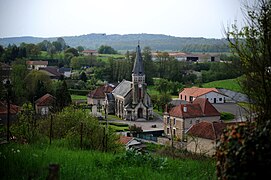Cheppy | |
|---|---|
 The town hall in Cheppy | |
| Coordinates: 49°13′57″N 5°03′32″E / 49.2325°N 5.0589°E | |
| Country | France |
| Region | Grand Est |
| Department | Meuse |
| Arrondissement | Verdun |
| Canton | Clermont-en-Argonne |
| Intercommunality | Argonne-Meuse |
| Government | |
| • Mayor (2020–2026) | Jean-François Lamorlette[1] |
| Area 1 | 14.83 km2 (5.73 sq mi) |
| Population (2021)[2] | 155 |
| • Density | 10/km2 (27/sq mi) |
| Time zone | UTC+01:00 (CET) |
| • Summer (DST) | UTC+02:00 (CEST) |
| INSEE/Postal code | 55113 /55270 |
| Elevation | 155–239 m (509–784 ft) (avg. 169 m or 554 ft) |
| 1 French Land Register data, which excludes lakes, ponds, glaciers > 1 km2 (0.386 sq mi or 247 acres) and river estuaries. | |

Cheppy (French pronunciation: [ʃɛpi]) is a commune in the Meuse department in Grand Est in northeastern France.
It was a site of fighting during World War I. An American monument sculpted by Nancy Coonsman was erected there by the State of Missouri after the war to honor the volunteers of the state.
Environment
[edit]- Cheppy wood
- Valley and banks of the Buanthe
See also
[edit]
References
[edit]- ^ "Répertoire national des élus: les maires". data.gouv.fr, Plateforme ouverte des données publiques françaises (in French). 2 December 2020.
- ^ "Populations légales 2021" (in French). The National Institute of Statistics and Economic Studies. 28 December 2023.







Well, that’s interesting to know that Psilotum nudum are known as whisk ferns. Psilotum nudum is the commoner species of the two. While the P. flaccidum is a rare species and is found in the tropical islands. Both the species are usually epiphytic in habit and grow upon tree ferns. These species may also be terrestrial and grow in humus or in the crevices of the rocks.
View the detailed Guide of Psilotum nudum: Detailed Study Of Psilotum Nudum (Whisk Fern), Classification, Anatomy, Reproduction